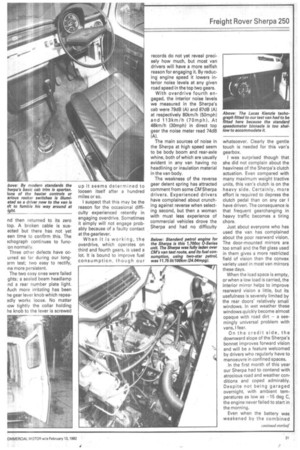Summit report. modest climbel
Page 28

Page 29

Page 30

If you've noticed an error in this article please click here to report it so we can fix it.
The standard long-wheelbase 1,700cc engine van coped admirably with ice and snow but for most operators the two-litre version must be a better choice.
BL's Sherpa has a formidable mountain to climb. In 1981 Sherpa sales and market share in the non-car-derived van sector of the British cv market both fell dramatically from 1980 levels, writes Tim Blakemore.
While all van manufacturers suffered from last year's depressed demand, none was harder hit than BL with annual home sales plummeting by 42 per cent to 8,540 vehicles.
As part of the strategy intended to reverse this trend, Freight Rover, a new company within the parent corporation was formed in mid-1981. Its name reflects its dual responsibility for the production and marketing of present and future Sherpa and Land-Rover vehicles.
There are already some small signs that the new company, under the managing directorship of Tony Gilroy (whose previous responsibility was Austin Metro car production) is achieving limited success. At the time of going to press the complete registration figures for January this year were not available but it looks as though the Sherpa may have taken second place in the highly competitive van market, displacing Bedford's CF.
Predictably, Ford's Transit continues to reign supreme. Transit sales figures are quite astonishing, surprising even some Ford personnel. Last year, for example, some 32,000 Transits were registered in Britain, almost four times the Sherpa total. Can it be that the Transit is four times better than the Sherpa? That is difficult to swallow.
Last year CM completed a 40,000km (25,000 miles) longterm Transit 80 test which taught us a lot about the model. Now we have begun a similar test of a Sherpa.
The van is a 250 Basic model fitted with the standard 1,700cc ohc, 0-Series petrol engine, as used in Princess and Ital cars. Optional extras fitted to our test vehicle include overdrive o third and fourth gears, and Landi-Hartog lpg (dual-fue conversion. We also have a Li cas Kienzle tachograph fitted 1 the Sherpa so that accural records may be kept of all ( journeys.
The standard speedomet( binnacle is too shallow to houa the deep tachograph head, s the instrument has had to mounted on a bracket fitted i front of the shelf on the nearsid of the facia. Despite being at gled towards the driver, it nevertheless difficult to rea from the driver's seat.
It is just as welt therefore ON the original speedometer ha been left in place and is open tional. Or rather was operationi up until last week when, whil the van was being driven up th M1 towards MIRA, the speed needle flickered violently twic
nd then returned to its zero top. A broken cable is suseCted but there has not yet een time to confirm this. The 5chograph continues to funcion normally.
Three other defects have ocurred so far during our longerm test; two easy to rectify, ine more persistent.
The two easy ones were failed ghts; a sealed beam headlamp Ind a rear number plate light. rluch more irritating has been he gear lever knob which repeaedly works loose. No matter low tightly the collar holding he knob to the lever is screwed up it seems determined to loosen itself after a hundred miles or so.
I suspect that this may be the reason for the occasional difficulty experienced recently in engaging overdrive. Sometimes it simply will not engage probably because of a faulty contact at the gearlever.
When it is working, the overdrive, which operates on third and fourth gears, is used a lot. It is bound to improve fuel consumption, though our records do not yet reveal precisely how much, but most van drivers will have a more selfish reason for engaging it. By reducing engine speed it lowers interior noise levels at any given road speed in the top two gears.
With overdrive fourth engaged, the interior noise levels we measured in the Sherpa's cab were 79c1I3 (A) and 87dB (A) at resPectively 80km/h (50mph) and 1 1 3km/h (7 Omph). At 48km/h (30mph) in direct top gear the noise meter read 74dB (A).
The main sources of noise in the Sherpa at high speed seem to be body boom and rear-axle whine, both of which are usually evident in any van having no headlining or insulation material in the van body.
The weakness of the reverse gear detent spring has attracted comment from some CM Sherpa drivers. Experienced drivers have complained about crunching against reverse when selecting second, but then a woman with must less experience of commercial vehicles drove the Sherpa and had no difficulty whatsoever. Clearly the gentle touch is needed for this van's gearbox.
I was surprised though that she did not complain about the heaviness of the Sherpa's clutch actuation. Even compared with many maximum weight tractive units, this van's clutch is on the .heavy side. Certainly, more effort is required to depress the clutch pedal than on any car I have driven. The consequence is that frequent gearchanging in heavy traffic becomes a tiring chore.
Just about everyone who has used the van has complained about the poor rearward vision. The door-mounted mirrors are too small and the flat glass used in them gives a more restricted field of vision than the convex variety used in most van mirrors these days.
When the load space is empty, or when a low load is carried, the interior mirror helps to improve rearward vision a little, but its usefulness is severely limited by the rear doors' relatively small windows. In wet weather these windows quickly become almost opaque with road dirt — a seemingly universal problem with vans, I fear.
On the credit side, the downward slope of the Sherpa's bonnet improves forward vision and will be a feature welcomed by drivers who regularly have to manoeuvre in confined spaces.
In the first month of this year our Sherpa had to contend with atrocious road and weather conditions and coped admirably. Despite not being garaged overnight, with ambient temperatures as low as —15 deg C, the engine never failed to start in the morning.
Even when the battery was weakened by the combined
effect of the low temperature. and more than normal use of electrical components and could only turn the starter motor very slowly, there was never any doubt about the engine's willingness to fire up.
Traction on slippery road surfaces, for a rear-wheel-drive vehicle was also surprisingly good. With about 500kg of test weights on board the Sherpa easily climbed many a slippery gradient that had numerous other vans performing none too. graceful pirouettes.
The van has an unusually long wheelbase and this gives it good stability. Together with the gen-. erous plated weights of the axles. it also helps to allow latitude for unevenly distributed loads. And the payload capacity of the.250 Sherpa is better than average.
Even with the Landi-Hartog equipment adding about 100kg (220Ib) to the kerb weight, our test van could carry 1,165kg of goods when a 75kg driver was on board. Maximum payload of the rival 2.3-litre petrol Bedford CF, tested in CM May 9 1981, for example, was 1100kg.
But the smaller engined Freight Rover van comes nowhere near matching that Bedford's motorway performance. The Sherpa, even when fully laden, can maintain 70mph on the flat with little fuss, but the slightest hill pulls that speed down and a change down out of overdrive is frequently called for.
The power output of the 1,700cc 0-Series engine is modest for a vehicle of this size. Over 30 per cent more power and 25 per cent more torque and probably just as good fuel consumption is offered by the optional two-litre 0-Series petrol engine which is likely to be the better choice for most operations. The additional cost of this engine is a miserly £50 — an offer that can hardly be refused, in my view.
The recent bad road and weather conditions have certainly had an adverse effect on our Sherpa's average fuel consumption to date. It is hovering around the 20mpg mark. Over our Thames Valley test route the fully laden van's mpg was 24.04, improving to 32.15mpg when unladen.
We have only just begun to run the van on gas and will have some performance figures for this fuel by the date of the next progress report.
















































